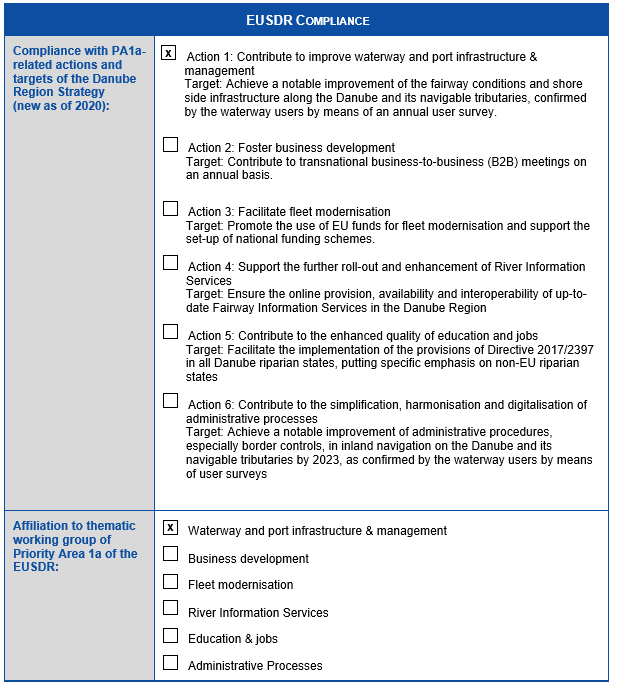BASIC PROJECT DATA
Project ID: PA1A147
Project Website: www.fairwayworks.org
NEED AND ADDED VALUE FOR THE DANUBE REGION STRATEGY
550 million tonnes of freight were moved on European inland waterways in 2018. Along the whole TEN-T core network corridor “Rhine-Danube”, the inland waterway transport performance accounted for 135 billion ton-kilometres in 2018. Navigation on the European Inland waterways is highly internationalised, as 75% of EU waterway traffic crosses borders. Existing bottlenecks and unreliable transport infrastructure in one country have significant negative impacts on the whole Danube corridor.
Despite the well-known advantages of Inland Waterway Transport compared to other transport modes, a stable loss in market share is taking place. A major driver for the losses is seen in lacking reliability of the waterway infrastructure and existing bottlenecks – such as insufficient fairway depths and widths or outdated infrastructure in mooring places or at locks. These obstacles usually have an international dimension due to average transport distances along the Danube of around 600 km.
The shortcomings regarding infrastructure represent a severe threat to the success of waterway transport in the Danube corridor and all over Europe. Consequently, achieving some of the main European transport policy goals is at risk if these shortcomings are not tackled.
OBJECTIVE(S) OF THE PROJECT
The general objectives of the trans-European network are to contribute to:
- Cohesion: through accessibility and connectivity, reduction of infrastructure quality gaps, etc
- Efficiency: through the removal of bottlenecks, interconnection, etc.
- Sustainability: through clean transport, reduction of external costs, etc
- Increased benefits for its users: through meeting transport needs, increased safety, etc.
Specific inland waterways transport infrastructure requirements include (among others) the following targets:
- Comply with the minimum requirements for class IV waterways (ECMT)
- Preserve a good navigation status
The proposed Action “FAIRway works!” contributes to all of these objectives by reducing infrastructure quality gaps and improves efficiency (e.g. Iron Gate lock, improved fairway marking, high-quality mooring places), increasing sustainability (through fostering inland navigation as such, increasing its capacity and reducing travel times for marking trips, offering shore side electricity) and increasing the benefits for its users (quality and availability of mooring places, increased safety at locks, improved surveying information and improved fairway marking).
“FAIRway works!” clusters and implements the most mature waterway-related initiatives in the corridor at this point in time. It represents a major step in the implementation of the Corridor Work Plan and will trigger additional investments (e.g. mooring infrastructures in other Danube countries).
CONDUCTED AND PLANNED PROJECT ACTIVITIES
The proposed actions shall substantially improve the quality of Danube waterway and related infrastructure and will therefore result in more competitive, more reliable, more sustainable and safer Danube navigation operations.
1.: Upgrade of Iron Gate II navigational lock (Serbia):
The reconstruction and upgrade of the Iron Gate II navigational lock will improve functional performance of the lock and reduce the duration of its lock cycles. Moreover, reliability, predictability and stability of operations will be increased, resulting in a decrease of waiting times for vessels, the elimination of unscheduled downtime risks, improved safety of navigation and improved overall Good Navigation Status parameters on the Danube waterway.
2.: Upgrade of infrastructure for mooring operations (Austria):
The objective is to – by the year 2030 – secure availability of well-equipped mooring places (dolphins or vertical riverbank constructions) within a range of 2.5 hours travel time down-stream and 5 hours up-stream respectively on the Austrian Danube. The proposed Action includes the upgrade of three public mooring places in Austria: mooring places in Linz, Vienna and Wildungsmauer (located in the free-flowing section east of Vienna) will be turned into state-of-the-art facilities that comply with today’s and tomorrow’s quality standards. The upgrades will lead to increased safety of mooring, embarking and disembarking operations, improved planning of resting and consequently travel times; and improved environmental integration and protection by decreasing emissions with installation of shore-side electricity facilities.
3. Procurement of equipment to ensure year-round navigability (Austria and Serbia):
The objective for this action is to ensure year-round navigability through the procurement of one high-quality multifunctional marking vessels in Austria and Serbia respectively and, in addition, a state-of-the-art surveying vessel and AIS AtoNs in Serbia. This equipment shall facilitate the exploitation of the benefits of the dynamic fairway marking approach. The surveying modules installed on the multifunctional vessels and the additional surveying vessel in Serbia enable gathering of up-to-date riverbed data required for efficient marking and dredging interventions. In Serbia, AIS AtoNs will be procured additionally. These enable the digital supervision of fairway marks and thus much faster detection of dislocated buoys and provision of precise information to navigation users through electronic navigational maps. The Austrian multifunctional marking vessel will additionally be equipped with a meeting room and can thus be used for on-site coordination meetings – for instance with navigation authorities, inland waterway users or Transboundary River Commissions – to facilitate rapid decision-making processes. Furthermore, it will be equipped with icebreaking equipment, which will help to reduce disruptions due to formation of ice (e.g. in locks, ports, waterway service centers, public mooring places in side-arms) and also contribute to ensuring year-round navigability.
TRANSBOUNDARY IMPACT
The project addresses the Core Network Corridor Rhine-Danube (more particular the pre-identified project Danube waterway from Kehlheim – Consţanta/Midia/Sulina as well as the Sava). With national stretches between 138 km and 1,075 km and average transport distances exceeding 600 km on the Danube, actions related to fairway conditions necessarily are of a cross-border nature. The project will be implemented by Austria and Serbia, but due to the linearity of the Danube transport axis, actions related to waterway infrastructure conditions in one country have an effect on all other Danube riparian countries (Germany, Austria, Slovakia, Hungary, Croatia, Serbia (third country), Romania, Bulgaria, Moldova (third country), Ukraine (third country).
The proposed Action results in improved and more reliable waterway infrastructure, which is the basis for higher market shares of the environmentally friendly transportation mode. The foreseen measures will provide stability and sustainability, where users of inland waterways will face improved framework conditions. The improved reliability and safety of waterway infrastructure of the Rhine-Danube Corridor will increase commitment of various stakeholders attracting new transport flows. This will also have an added value on ports and hinterland transportation, as well as increased leisure activities and tourism.
Besides the positive effects of the proposed Action on the commitment of the stakeholders representing the waterway users, positive effects on the commitment of environmental stakeholders are to be expected: the procurement of equipment for year-round navigability (Marking & surveying vessels and AtoNs) opens opportunities for dynamic fairway marking as an alternative to maintenance dredging in certain settings. This would reduce the need for physical interventions in the waterway, thereby reducing environmental impacts. The equipment of public mooring places with shore-side electricity facilities also reduces the local noise nuisance and emissions to air of conventional diesel generators.
PROJECT BENEFICIARIES / TARGET GROUPS
Beneficiaries:
- Federal Ministry of Climate Action, Environment, Energy, Mobility, Innovation and Technology (AT) Designated implementing body: via donau – Österreichische Wasserstraßen-Gesellschaft
- Ministry of Construction, Transport and Infrastructure, Directorate for Inland Waterways (RS)
Target groups:
- Waterway users (e.g. operators of cargo and cruise vessels, fleet and terminal operators)
- Environmental (non-governmental) organisations such as WWF
- European Commission, in particular DG MOVE, INEA and DG Environment
- Danube Commission and Sava River Basin Commission
- National Governmental authorities, such as Ministries of Transport, Ministries of Environment
- Waterway and Canal Administrations and lock operators along the Danube
STATUS AND TIMEFRAME
Start date: March 1st, 2020
End date: December 31st, 2024
FINANCING
Total budget: 42,576,144 EUR
EU funds: 17,030,458 EUR are funded by CEF
PROJECT TEAM
Project leader:
- Federal Ministry of Climate Action, Environment, Energy, Mobility, Innovation and Technology (AT)
- Designated implementing body: via donau – Österreichische Wasserstraßen-Gesellschaft
Address: Donau-City-Straße 1, 1220 Vienna, Austria
Project partner(s):
- Ministry of Construction, Transport and Infrastructure, Directorate for Inland Waterways (RS)
PROJECT ENVIRONMENT
PROJECT CROSS – REFERENCE
FAIRway Danube (PA1A108) and Preparing FAIRway 2 works in the Rhine-Danube Corridor
STRATEGIC REFERENCE
- Third Rhine-Danube Corridor Work Plan of the European Coordinator (February 2018).
- NAIADES II
- “EU Strategy for mobility and transport: measures needed by 2030 and beyond” currently under development
- Guidelines towards achieving a Good Navigation Status (GNS)
- Fairway Rehabilitation and Maintenance Masterplan for the Danube and its navigable tributaries
RELEVANT LEGISLATION
- TEN-T Guidelines (e.g. Reg. 1315/2013)
- COM(2019) 640 final) “European Green Deal”
EUSDR EMBEDDING

EUSDR COMPLIANCE

META DATA
Data provided by: ViaDonau (Andreas Bäck – 16.10.2020)
Download pdf.


